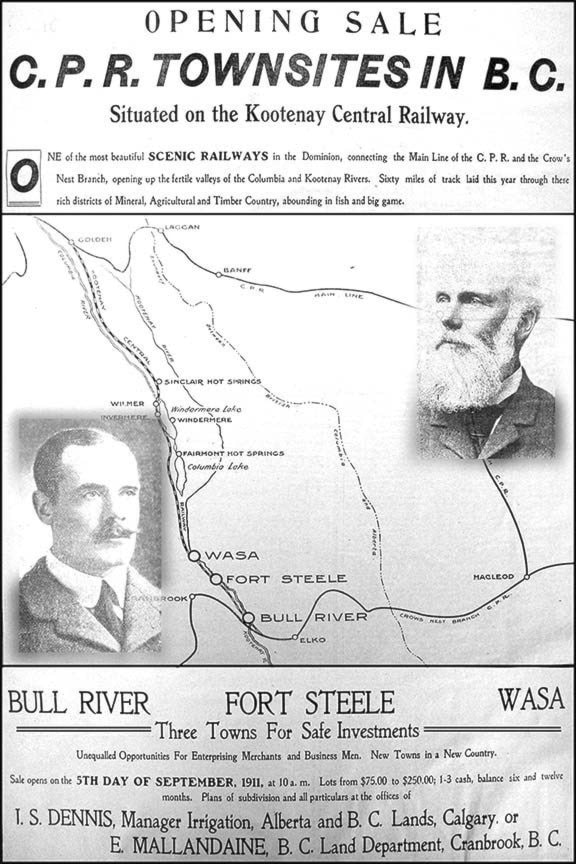Jim Cameron
When Canadian Pacific Railway financier Donald Smith pounded in the last spike at Craigellachie, B.C., on Nov. 7, 1885, he succeeded in not only joining two ends of a railway but, more importantly, two sides of a continent.
It was a move that unified the vast land that was Canada, allowing resources, manufactured goods and the populace to travel from east to west and back again.
The westernmost portion of the transcontinental railway ran from Winnipeg to Calgary, through the Rockies at Banff and, via Golden and Kamloops, onwards to Port Moody on the west coast.
This did little for the East Kootenay, mind you. It wasn't until 1898, when the Crows Nest Division of the CPR ran a line from Lethbridge through the Crows Nest Pass via Fernie and Cranbrook to Kootenay Landing on Kootenay Lake, that the East Kootenay began to boom.
For many, that was enough. For others, it was close but no cigar. Among the most displeased by the choice of the southern CPR route was Dr. Hugh Watt of Fort Steele.
In a letter of Aug. 8, 1907, to the Cranbrook Herald, Dr. Watt states "Cranbrook stole our government offices from us and are now patting themselves on the back because they fancy they have succeeded in stealing our railway."
In truth, there were an awful lot of people in Fort Steele upset with the CPR. In 1897, Fort Steele was the main centre in a district that (they claimed) boasted over 3,000 people. It housed the government offices, it was a stunning location with plenty of natural resources and therefore it was, it was supposed, the perfect spot for the divisional headquarters of the new railway. So what went wrong?
Various theories abound, among the most prominent being that Cranbrook town-founder James Baker plied his nefarious political talents in order to redirect the railway through his privately held lands which would become Cranbrook, thereby making his a great deal of money.
There may be some weight behind the argument although the loudest accusations emanated from Fort Steele where, it can be argued, landowners were robbed of the opportunity to sell their own privately held lands to the CPR at highly inflated prices.
The CPR merely stated that it was more viable to run the rails across the Kootenay River to Wardner and on onward to Cranbrook. This also may be true, although the later appearance of the railway which runs past Fort Steele and on to Golden and is in use to the present day seems to somewhat belie that theory.
It should be noted at this point that even though this article chiefly concerns the Kootenay Central Railway, that particular subject may not make much of an appearance on this page at the present time, depending entirely on the amount of words required to set the whole thing up. Nonetheless, no matter how long it takes to get to the Kootenay Central Railway, have no doubt that it will happen in a much shorter time than it took the actual Kootenay Central Railway to arrive at Fort Steele.
Dr. Hugh Watt, for those who have toured Ft. Steele Heritage Town and seen his very small doctor's office, may be imagined as little more that a small-town, small-time, general practitioner driving his little black buggy here and there in order to heal the sick of the countryside. Fair enough, he was that. But that is only part of the Watt equation.
He was born in Fergus, Ontario on Sept. 9, 1840, to John (James) Watt, a merchant, and Catharine Watt, daughter of a local hotel-keeper. His biggest claim to fame, family-wise (according to some) is the fact that he is the great-grandson of James Watt, whose improvements to the steam engine pretty much kicked-started the Industrial Age. That alone would make Dr. Watt worthy of mention in terms of locals who can slip into some fancy-dandy ancestry pants.
Regardless, Dr. Watt cut his own swath. He owned and published the Fergus News-Record newspaper before he took up the study of medicine at Toronto University. Following his graduation he set up shop in Toronto for a time before travelling to the Cariboo where he became surgeon in charge of the Barkerville Hospital from 1892-95, two years of which, as a staunch Liberal, he served as representative in the Provincial Legislature. He moved on to Fort Steele in 1897, where he became Health Officer for the district, acting as surgeon for the railway, various mining and logging camps and the St. Eugene Mission Hospital.
He was a talented writer and orator, fluent in a number of languages, a Presbyterian Church elder, a member of the Masonic Lodge, a widower and father of two sons; one of whom practiced medicine in Toronto and the other a lawyer in Victoria. But, for all that, among the things he wanted most was to see the railway come to Fort Steele.
And now on to Clement Hungerford Pollen, peer of the realm, landed gentry in the spanking new town of Cranbrook and soon to be — What's that? Out of room? Dang.
Well, have a look at Mr. Pollen's picture and commit the image to memory. It will not appear again when next he is mentioned, which will not be next week because next week is Halloween and, in honour of that night of fright, Janus will be occupied with James "Bluebeard" Watson, an oft-ignored forger, bigamist and serial killer who plied his trade in the Cranbrook of old.
Following that, it will be back on board the Kootenay Central Railway high-balling towards the future.
janusthenandnow@shaw.ca
